The Adaptive Immune Response (A-level Biology)
The Adaptive Immune Response
Activation of the Adaptive Immune Response
- Antigen presenting cells (APCs) activate the adaptive response. In the last tutorial, we discussed how leukocytes (macrophages and neutrophils) break down pathogens via phagocytosis, and how they can also present antigens. The three major leukocytes which carry out antigen presentation are the macrophages, dendritic cells, and to a lesser extent, neutrophils.
- APCs present the antigens of foreign pathogens. APCs phagocytise foreign pathogens and present their antigens to the innate immune system. When macrophages and dendritic cells come in contact with a foreign pathogen, they phagocytise it. Following phagocytosis of the pathogen, the following events occur in this order:
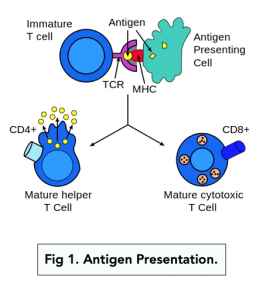
Lymphocytes
We have just learnt about leukocytes (macrophages and neutrophils). Lymphocytes are another type of white blood cell, which are present in the blood and lymphatic system. There are two types of lymphocytes:
- T cells primarily kill pathogens and active B cells.
-
- T cells originate in bone marrow and mature in the thymus.
- T cells are activated by APCs (e.g. macrophages).
- T-helper cells activate B cells and cytotoxic T cells .
-
- B cells primarily produce antibodies and memory cells.
-
- B cells originate and mature in bone marrow.
- B cells are activated by Helper T cells.
-
We will learn about each of these in more detail below.
T Lymphocytes and Cell-Mediated Immunity
Origin and Maturation
- T-cells originate in the bone marrow. T cells originate in the bone marrow, where they are formed from adult stem cells known as hematopoietic stem cells.
- T cells mature in the thymus. Following their formation, immature T-cells are transported to the thymus, where they are referred to as thymocytes. Thymocytes undergo maturation and a process called clonal deletion in the thymus (see next section).
- T cells are found in blood and lymph. Following maturation, they exit the thymus and are dispersed throughout the lymphatic tissue and other tissues where they are referred to as mature T-cells.
Clonal deletion and anergy
Lymphocytes (i.e. Helper T-cells, Cytotoxic T-cells, and B-cells) need to be able to recognise and tolerate self-antigens.
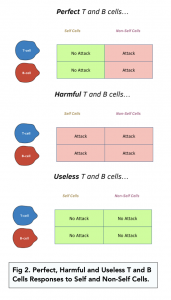
Clonal deletion involves deleting any immune cells that respond to self-antigens. This occurs in two ways:
- Central Tolerance: During maturation, all B-cells and T-cells travel through a tissue matrix which contains all of the self-antigens that can be found in the body. If a T-cell or a B-cell reacts with any of these self-antigens, it is killed off via apoptosis. This overall process is known as clonal deletion, and it leaves immune cells which do not respond to self-antigens.
- Peripheral Tolerance: It is very similar to central tolerance but occurs at a stage where the T-cells and B-cells are still immature. Clonal deletion removes immature T and B cells which respond to self-antigens.
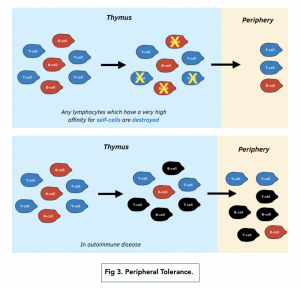
Clonal anergy involves activating any immune cells that bypass clonal deletion.
Steps of T-Cell Action
TC = cytotoxic
TM = memory
TH = helper
TR = regulatory
1. Phagocytosis and antigen presentation. As we have studied before, neutrophils and macrophages phagocytose the pathogens, and then act as APCs and present antigens to T-helper cells.
2. TH cells are activated. TH cells are activated by APCs. Upon activation, the main role of TH cells is to activate the pathogen-specific TC, TM and B-cells. TH cells also produce cytokines that increase proliferation of these cells, and produce interferons which increase the immune response.
3. TC cells kill pathogens. The TC launch a direct attack on the particular pathogen. We will learn the specific mechanism next up.
4. TM cells provide long-term immunity. We will learn about memory cells later.
5. TR cells regulate other white blood cells. They inhibit the immune response of other white blood cells to prevent them from wrongly attacking the body’s own cells.
6. B cells produce antibodies. B-cells produce antibodies specific to the pathogen.
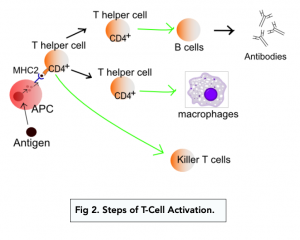
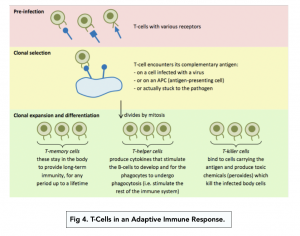
Mechanism of Cytotoxic T cells
The main purpose of TC cells is to kill cells infected with viruses by causing apoptosis. The mechanism is as follows:
7. TC cell binds to an infected cell. T cells binds to the MHC molecules of an infected cells.
8. Perforins are produced. The TC cell produces proteins known as perforins, which bind to the cell surface membrane of the target cell and pierce holes in (perforate) the membrane.
9. Granzyme enzymes are produced. The TC cell produces enzymes known as granzyme A and granzyme B. These enzymes pass through the pierced holes in the membrane and into the cell.
10. Granzyme A poisons the cell. Granzyme A catalyzes reactions which poison the target cell.
11. Granzyme B destroys the cell. Granzyme B catalyzes reactions which destroy the target cell.
12. Apoptosis occurs via Fas binding. TC cells express a protein known as the Fas ligand on their cell surface membrane. When a TC cell binds to a target cell, the Fas ligand binds to the Fas receptor which is found on the cell surface membranes of most cells. Activation of the Fas receptor in the target cell leads to activation of apoptosis
13. Interferons are released. Before the target cell undergoes apoptosis, it produces and secretes interferon proteins. Interferons inhibit viral replication in the surrounding area, and increase the anti-viral defence mechanisms of other body cells.
14. Antibodies can deal with the remaining viruses. When the target cell undergoes apoptosis, many virus cells are released. Antibodies can deal with these virus cells. Antibodies are constantly present in the blood stream and inside tissues. Upon recognising a particular virus, the antibodies bind to it, and opsinate it. Opsination of a virus covers its attachment proteins which prevent it from binding to and infecting other cells.
B-Cells and Humoral Immunity
B cells, like T cells, are each specific against a particular antigen and pathogen. Similarly, a particular B cell will be activated by a particular TH cell.
- TH cells activate B cells. TH cells activate pathogen specific B cells.
- B cells proliferate. Once activated, the B cell will rapidly proliferate (via mitosis) through a process known as clonal expansion. Clonal expansion typically takes a few days to occur.
- B cells differentiate. During clonal expansion, the rapidly proliferating B cells differentiate into either plasma cells or B memory cells.
-
- Plasma B Cells: Plasma cells are short lived cells whose main function is to produce large amounts of antibodies against a particular antigen. Their main function is during the infection itself, also known as the primary immune response.
-
- Memory B Cells: Memory B cells are mainly involved in the secondary immune response, or the second time the body is infected by the same pathogen. Upon secondary infection by the same pathogen, memory B cells rapidly differentiate into plasma B cells in order to quickly produce antibodies against the pathogen. In doing so, the second time the infection occurs, the body is able to fight it much more quickly and effectively than the primary infection. This mechanism is often referred to as immunological memory. This immunological memory is what provides many organisms, including humans, with long term immunity against particular pathogens.
B cells and their antibodies contribute to humoral immunity.
Humoral immunity can be defined as immunity maintained by secreted macromolecules in the blood stream or lymphatic fluid. Antibodies are the major players in maintaining humoral immunity.
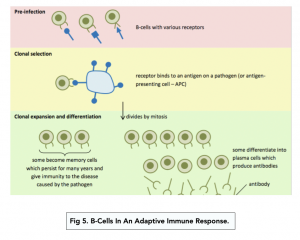
The adaptive immune response is a sophisticated defense mechanism that is activated when the body is exposed to foreign substances, such as pathogens or harmful substances. This response is specific to each individual exposure and can produce a tailored response to combat the invading agent. The adaptive immune response is essential for the survival of living organisms and plays a crucial role in preventing disease.
The adaptive immune response works by recognizing and responding to specific antigens, which are foreign substances that trigger an immune response. This recognition occurs through the interaction of immune cells, such as T and B cells, with specific antigen-presenting cells. When an antigen is recognized, the immune system produces specific antibodies that can neutralize the invader and prevent it from causing harm.
T cells and B cells are two different types of immune cells that play important roles in the adaptive immune response. T cells are responsible for recognizing antigens and triggering an immune response, while B cells produce specific antibodies that neutralize the invading agent. Both T and B cells are essential for a successful adaptive immune response and work together to provide a coordinated defense against harmful substances.
The adaptive immune response has the ability to remember previous exposures to specific antigens. This allows the immune system to respond more quickly and effectively to future exposures to the same antigen. This process of memory is achieved through the survival of specific immune cells, such as memory T and B cells, which can respond quickly to subsequent exposures to the same antigen.
The adaptive immune response is essential for preventing disease by recognizing and neutralizing harmful substances, such as pathogens. The ability to produce specific antibodies and remember previous exposures to antigens means that the adaptive immune response can provide a rapid and effective defense against future exposures to the same invader. This ability to respond quickly and effectively to harmful substances is crucial for the survival of living organisms and helps to prevent the spread of disease.






Still got a question? Leave a comment
Leave a comment